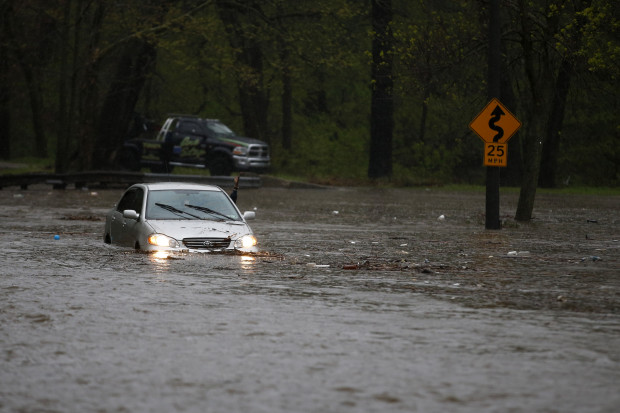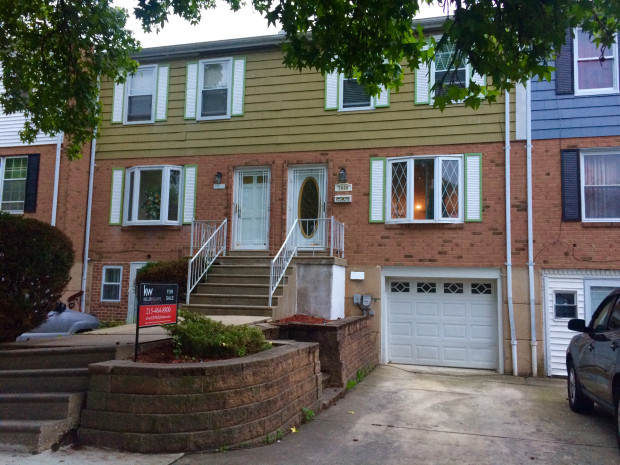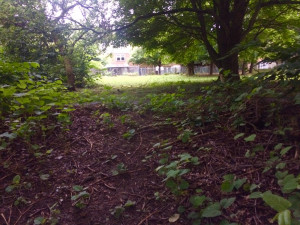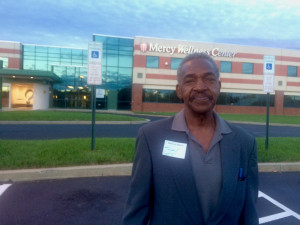How one Philadelphia neighborhood battles rising tides

AP Photo
A man waves for a tow truck after getting swamped trying to cross a flooded section of the Cobbs Creek Parkway, Wednesday, April 30, 2014, in Philadelphia. Cobbs Creek and Darby Creek merge in the Eastwick section of Philadelphia where flooding is expected to get worse due to rising sea levels.
Joining dozens of communities across the country Philadelphia Mayor Jim Kenney announced Wednesday he has committed the city to a goal of 100 percent clean energy. It’s part of a growing effort by cities and states to reduce their carbon footprint in the wake of President Trump pulling out of the Paris Agreement, a landmark international effort to cut global carbon emissions to reduce the worst impacts of climate change.
In the Philadelphia region, climate scientists say those impacts will include hotter summers, greater rain fall and floods.
One city neighborhood is already working on how to respond to rising sea levels. Climate change is not theoretical for residents of Eastwick, a neighborhood built over a marsh in southwest Philadelphia. The area is already subject to frequent and severe flooding, and researchers say it will only get worse.
At least ten high flow events since 1999 have seriously damaged about 130 properties and city infrastructure, according to the Philadelphia Water Department.
Floodwaters have damaged the home of Eastwick resident Janis Pugh several times.
“It comes up to this garage door, all the way up to the top,” said Pugh outside her home on Saturn Place.
Philadelphia is expected to be hit by more frequent and heavier rains and storms, and rising seas across the globe will result in more flooding along the tidal Delaware and Schuylkill rivers.
Pugh’s street, lined with two story row houses with garages on the ground level, is next to Eastwick Park. The park is the former Clearview Landfill and is now part of the Lower Darby Creek Superfund site. Cobbs Creek runs nearby, and two blocks south lies the confluence of Cobbs and Darby creeks. There’s lots of trees, birds, and even deer.
But as idyllic as living here may sound, it can be stressful.

Catalina Jaramillo / StateImpact PA
Some residents are deciding to leave the neighborhood mostly because of high flooding insurance. Houses are still selling, neighbors say.
Eastwick was built in the 1960’s as part of an urban renewal project, aimed at improving a semi-rural area called the Meadows. There were a few houses and farms scattered among marshlands at the lowest point of Philadelphia, so it got wet.
But a flooded field is not a problem, the earth slowly absorbs the water. The problem began with development. Today when it floods, water runs like a river down the streets, creating flash floods.
“It comes so fast, you can’t even think,” said Pugh. “It’s like a wave, like an ocean. They bring in boats to take people out. And people… you lose your car, the water is over top of your car.”
Researchers say climate change will make flooding in Eastwick worse.
There are four different ways that Eastwick already floods, which scientists call the “quadruple threat.”

Catalina Jaramillo / StateImpact PA
Cobbs Creek overflows during heavy rains, the surge runs down the streets, within the houses, flooding residents ground floors.
Seasonal rainfall and snow increases the flow of Cobbs and Darby creeks. When the water hits the elevated Clearview Landfill it bounces back upstream, jumping off the creek into neighborhood homes. During heavy storms, the Schuylkill River pushes groundwater up into Eastwick. Sea level rise from the tidal Delaware River will make storm surges more damaging. And development in and around the Tinicum Marsh, especially the Philadelphia International Airport, has created a bottleneck, preventing water from flowing out of the neighborhood.
Pugh has lost furniture, electronics and personal belongings. With every flood comes remodeling, changing walls and floors, and fixing the foundations. And it get’s expensive. On top of that, she pays $3,000 a year for mandatory flood insurance.
“It’s a lot of stress on you,” Pugh said. “Everytime it rains, you get nervous, you get stressed out.”
A group of scientists, engineers and design professionals have been studying flood mitigation solutions for years. One idea was removing the Clearview Landfill, but a hydrology study concluded it wouldn’t be enough to halt the flooding. Another, more popular solution is building a levee.
The Army Corps of Engineers published a report in 2014 concluding that a $2.8 million levee was feasible and that it would stop Cobbs Creek from overflowing into Eastwick. But it would do that in part by raising water levels upstream and downstream. And that could cause flooding in neighboring communities like Elmwood or Colwyn Borough in Delaware County. The Army Corp’s project manager Erik Rourke said they need to further study ways to mitigate that impact.
The City of Philadelphia applied for this study two years ago, committing to pay its share of the total cost, which according to an Army Corps spokesperson would be less than $3 million. That would require federal dollars, with Congress having the final say, but Eastwick advocates are confident they will get it.
Amy Laura Cahn is a former attorney with the Public Interest Law Center of Philadelphia who has been advocating for Eastwick residents for more than five years.
“My question is, when Army Corps does its analysis, in evaluating the flood conditions and a range of possible solutions, are they going to be taking climate change into account?” Cahn said.
Sarah Wu, from Philadelphia’s Office of Sustainability, said the city is doubling its efforts on climate mitigation, but they don’t have extra funds to help communities like Eastwick.
“We need to be prepared to have the best solutions ready to go when federal funding becomes available again,” Wu said.

Catalina Jaramillo / StateImpact PA
Terry Williams was born in Eastwick. Today he leads the planning process and the Eastwick Friends and Neighbors Coalition (EFNC). He says he'll never leave Eastwick.
Meanwhile, Eastwick residents are going through a planning process to decide the future of 189 acres of undeveloped and public land in the neighborhood. The process includes city officials and scientists. Development of those acres can create solutions or make the problem worse.
Landscape architect Scott Bishop, working with Interface Studio on the planning process, recommended residents think about working “with the flow,” using the lowest points to hold water and divert it to the Schuylkill River and the Tinicum Marsh. Bishop advised them to let the wetlands be wetlands, create wet forests and water environments.
“So instead of a basketball court, maybe you have a kayak shack,” Bishop said, while showing pictures of people on kayaks and canoes.
Long term Eastwick resident Terry Williams says his heart was broken when he heard about President Trump’s decision on the Paris climate agreement. Global warming is not a far away event, it’s literally at his doorstep.
“It has already had an impact, you know, a lot of folks out here have some kind of flood warning in their psyche,” Williams said.
Some neighbors like Pugh are selling their homes while they still can. They won’t stay for more expensive flood insurance.
“Oh yeah, we’re moving,” Pugh said.
Others, like Williams, are rooted in their neighborhood, despite the unknown costs. “But I’m not going anywhere,” Williams said.
Williams says he’s hopeful because, for the first time, scientists and local officials are working with the community to find a solution.
Correction: An earlier version of this story stated the city’s clean energy goal had a timeline, it does not.
















